
Conidae, with the current common name of "cone snails", is a taxonomic family of predatory sea snails, marine gastropod molluscs in the superfamily Conoidea.

Conoidea is a superfamily of predatory sea snails, marine gastropod mollusks within the suborder Hypsogastropoda. This superfamily is a very large group of marine mollusks, estimated at 340 recent valid genera and subgenera, and considered by one authority to contain 4,000 named living species.
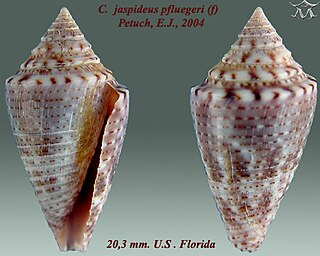
Jaspidiconus is a subgenus of sea snails, marine gastropod mollusks in the genus Conasprella, family Conidae, the cone snails and their allies.

Conus (Austroconus) is a taxon of sea snails, marine gastropod mollusks in the family Conidae. Although formerly described as a distinct subgenus, it is currently considered as an alternative representation of the cone snail genus, Conus.

Calamiconus is a subgenus of sea snails, marine gastropod mollusks in the genus Conus, family Conidae, the cone snails and their allies.

Californiconus is a genus of sea snails, marine gastropod mollusks. The experts at WoRMS place this group of species in the family Conidae, the cone snails, but some other experts placed previously the genus in a proposed family, the Conilithidae. This is a monotypic genus.
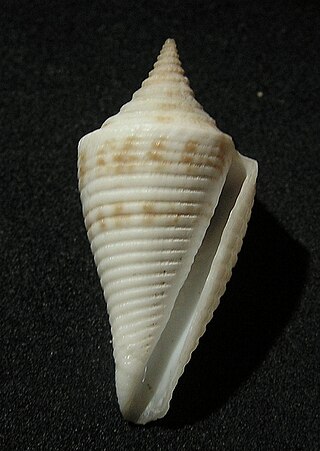
Conasprella is a genus of sea snails, marine gastropod mollusks in the family Conidae, the cone snails and their allies. This genus was formerly treated by some experts as a member of the family Conilithidae and as an "alternative representation" of this group of species.

Conasprelloides is a subgenus of sea snails, marine gastropod mollusks in the family Conidae, the cone snails and their allies.

Dalliconus is a subgenus of sea snails, marine gastropod mollusks in the genus Conasprella, family Conidae, the cone snails and their allies.
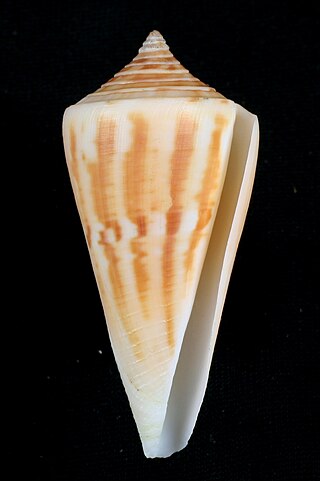
Dauciconus is a subgenus of sea snails, marine gastropod mollusks in the genus Conus, family Conidae, the cone snails and their allies.

The taxonomy of the cone snails and their allies as proposed by John K. Tucker and Manuel J. Tenorio in 2009 was a biological classification system for a large group of predatory sea snails. This system was an attempt to make taxonomic sense of the large and diverse group which contains the family Conidae, the cone snails. The authors proposed extensive changes to the family Conidae in contrast to the way the group was treated in the taxonomy of the Gastropoda by Bouchet & Rocroi, 2005. Bouchet and Rocroi included in the family Conidae several other groups of toxoglossan snails which had previously been placed in the Turridae.

Endemoconus is subgenus of sea snails, marine gastropod mollusks in the genus Conasprella, family Conidae, the cone snails and their allies.

Conilithidae is a proposed taxonomic family of small to medium-sized sea snails, specifically cone snails, marine gastropod mollusks in the superfamily Conoidea, the cone snails and their allies.
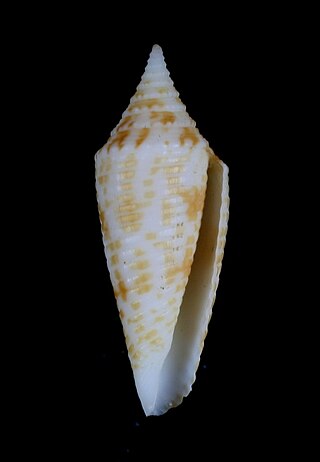
Fusiconus is a subgenus of sea snails, marine gastropod mollusks in the genus Conasprella, family Conidae, the cone snails and their allies.
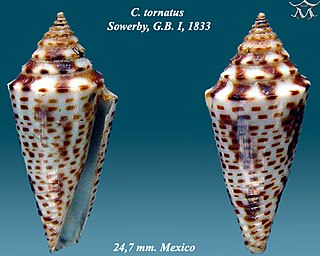
Globiconus is a subgenus of sea snails, marine gastropod mollusks in the genus Conasprella, family Conidae, the cone snails and their allies.

Gradiconus is a synonym of a subgenus of sea snails, marine gastropod mollusks in the genus Conus, family Conidae, the cone snails and their allies. T

Harmoniconus is a subgenus of sea snails, marine gastropod mollusks in the family Conidae, the cone snails and their allies.

Kohniconus is a subgenus of sea snails, marine gastropod mollusks in the genus Conasprella, family Conilithidae, the cone snails and their allies.

Lilliconus is subgenus of sea snails, marine gastropod mollusks in the genus Conasprella, family Conidae, the cone snails and their allies.

Parviconus is a subgenus of sea snails, marine gastropod mollusks in the genus Conasprella, family Conidae, the cone snails and their allies. This genus currently is still treated by some experts as an "alternative representation" of this group of species.

















